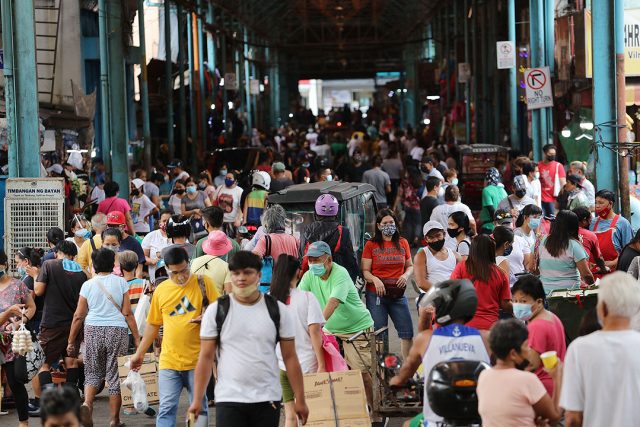Agricultural output slumps in Q3

By Revin Mikhael D. Ochave, Reporter
THE PHILIPPINES’ agricultural output shrank by an annual 2.6% in the third quarter as crops, livestock and fisheries production declined due to bad weather, the statistics authority reported.
The Philippine Statistics Authority (PSA) on Monday said the value of production in agriculture and fisheries slumped by 2.6% in the July-September period, a reversal of the 0.7% growth a year ago. The decline is also steeper than the -1.5% recorded in the second quarter.
“Production declines were noted for crops, livestock, and fisheries, while poultry grew during the period,” the PSA said in the report.
“At current prices, production in agriculture and fisheries was valued at P446.46 billion, an increase of 5.2% this quarter.”
Agriculture typically makes up around 10% of overall economic output, and a fourth of the country’s jobs. Third-quarter gross domestic product (GDP) data will be released today (Nov. 9).
For the first nine months of the year, the PSA said the value of production in the agriculture sector contracted by 2.5%, worse than the -0.2% recorded last year.
Agriculture Secretary William D. Dar said in a mobile phone message to BusinessWorld that the Department of Agriculture (DA) will have to do its best in the last two months to meet the 2% full-year growth target for sector.
Roy S. Kempis, Pampanga State Agricultural University professor, said the recent typhoons hampered agriculture production.
“Physical factors brought by weather-related events have continuously wreaked havoc on agriculture and food production. The weather elements and their destructive effects are known, but the DA should know the science on how to channel away the destruction with its own risk reduction measures,” Mr. Kempis said in a mobile phone message.
Federation of Free Farmers (FFF) National Manager Raul Q. Montemayor said in a mobile phone message that the DA should help farmers to recover faster from these typhoons.
“Recovery programs should be in place ahead of time especially during the typhoon season, such as provision of seeds, fertilizer, condonation of loans or crop insurance, and other support, so that they can help farmers immediately after the disaster,” Mr. Montemayor said.
Mr. Dar said the DA is already implementing programs to enhance the sector’s resiliency against typhoons.
“There is the early planting of rice, use of climate smart crop varieties, off-season planting of vegetables in greenhouses, and balanced fertilization strategy,” the Agriculture chief said.
CROPS OUTPUT FALLS
In the third quarter, crops production, which accounted for over half of the overall agricultural production, dipped by 0.2%. Palay or unmilled rice output went up by 6.7%, while corn production declined 18.6%.
“Crop damage caused by inclement weather in September also contributed to the overall struggles of the agricultural sector,” Nicholas Antonio T. Mapa, ING Bank N.V. Manila Senior Economist, said in an e-mail.
Based on DA data, agriculture damage caused by Typhoon Jolina reached P1.36 billion. The typhoon swept through Central Luzon, Calabarzon (Cavite, Laguna, Batangas, Rizal, and Quezon), Mimaropa (Mindoro, Marinduque, Romblon, and Palawan), the Bicol Region, Western Visayas, Central Visayas and Eastern Visayas.
The southwest monsoon enhanced by Typhoon Fabian also caused P698.53 million worth of farm losses.
Crops that posted lower production included abaca (-21.9%), cabbage (-18.1%), potato (-13%), onion (-8.1%), mongo (-7.6%), eggplant (-5%), coffee (-4.3%), ampalaya or bitter gourd (-3.8%), cacao (-3.6%), sweet potato (-1.4%), cassava (-0.3%), and banana (-0.2%).
On the other hand, higher production was recorded for sugarcane (110.8%), pineapple (13.1%), calamansi (8.3%), tobacco (3.2%), rubber (2.6%), coconut (1.9%), tomato (1.6%), and mango (0.6%).
ASF IMPACT
Livestock production, which made up 15.3% of the total, fell by 15.2% amid the prolonged outbreak of African Swine Fever (ASF).
PSA data showed lower production for hog (-17.8%), goat (-7.4%), dairy (-3.6%), and cattle (-2.5%), while carabao production improved by 9.5%.
Rolando E. Tambago, Pork Producers Federation of the Philippines, Inc. president, said the livestock subsector, particularly hogs, will continue to decline unless the government addresses issues such as the ASF outbreak.
“We expect the trend will continue even toward the end of the year unless the government will do something tangible to reverse the situation. One is the ASF outbreak, second is the low confidence of the hog industry to repopulate or increase production due to massive importation at low tariffs,” Mr. Tambago said in a mobile phone message.
To recall, President Rodrigo R. Duterte issued two executive orders that increased the allowable pork import volume and lowered the tariff rates of pork imports for one year.
Fisheries output, which accounted for 16.2%, slipped 0.4% in the third quarter.
A decline in production was seen for bigeye tuna (-41.1%), blue crab (-22.1%), frigate tuna (-21.1%), yellowfin tuna (-19.9%), threadfin bream (-19.1%), slipmouth (-12.4%), skipkack, (-11.8%), round scad (-11.8%), Indian mackerel (-7.8%), bali sardinella (-5.8%), and seaweed (-3.7%).
On the other hand, production increased for mudcrab (29.2%), milkfish (9.9%), big-eyed scad (9.7%), cavalla (9.4%), fimbriated sardines (7%), squid (5.7%), tilapia (5.7%), grouper (3.5%), and tiger prawn (1.6%).
“Aside from typhoons which made fishing more difficult, capturing fish in our seas is affected by the China factor that drives away our fishermen from their traditional fishing grounds,” Mr. Kempis said.
The Department of Foreign Affairs (DFA) said on Oct. 21 that it submitted 211 diplomatic protests since 2016 against China’s presence in the West Philippine Sea. However, Chinese vessels remain in the area.
Poultry was the only bright spot, growing by 1.3% in the third quarter. It accounted for 14.6% of the overall agricultural output. There was a drop in production of duck (-2.1%) and chicken (-1.4%), while an increase was seen in chicken eggs (8.1%) and duck eggs (7%).
“Broiler (production) declined because of poor demand, high input cost, high levels of frozen meat inventories both local and imported, and high arrivals of imports of chicken and pork,” United Broiler Raisers Association (UBRA) President Elias Jose M. Inciong said in a mobile phone message.
OUTLOOK DIMS
Industry experts said the DA’s growth target of 2% for this year may already be out of reach.
“It is definitely out of reach. The DA needs to recover too much ground before it can achieve the 2% target,” Mr. Montemayor said.
Mr. Kempis noted farm output in the fourth quarter would have been affected by Typhoon Maring, which caused up P2.26 billion in agricultural damage.
“With Typhoon Maring wreaking havoc in October, the growth for the fourth quarter of 2021 will be a challenge, making it difficult to achieve the 2% overall 2021 growth,” he said.















